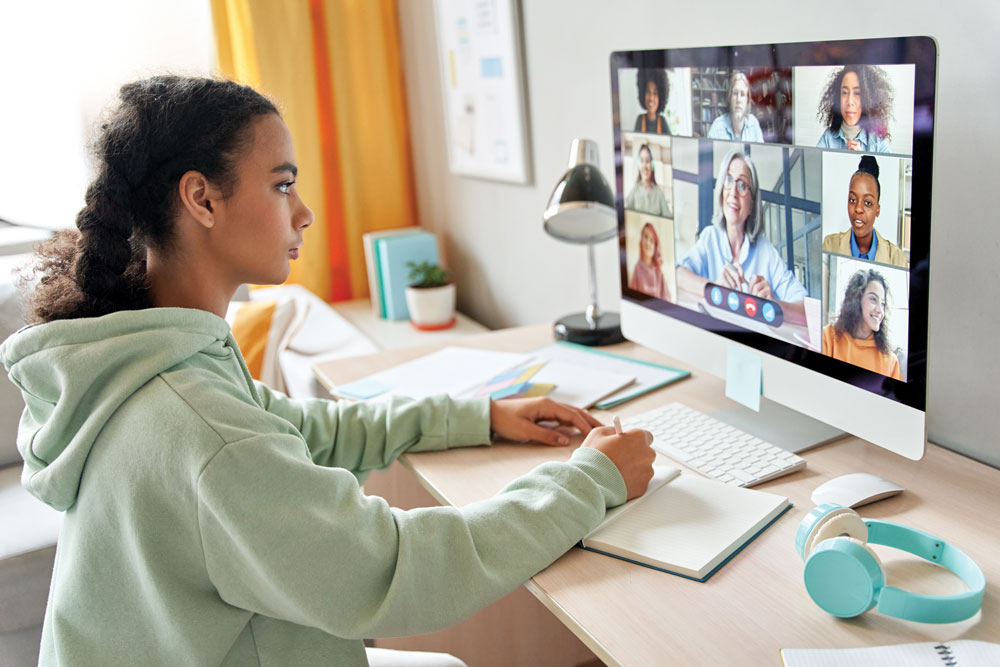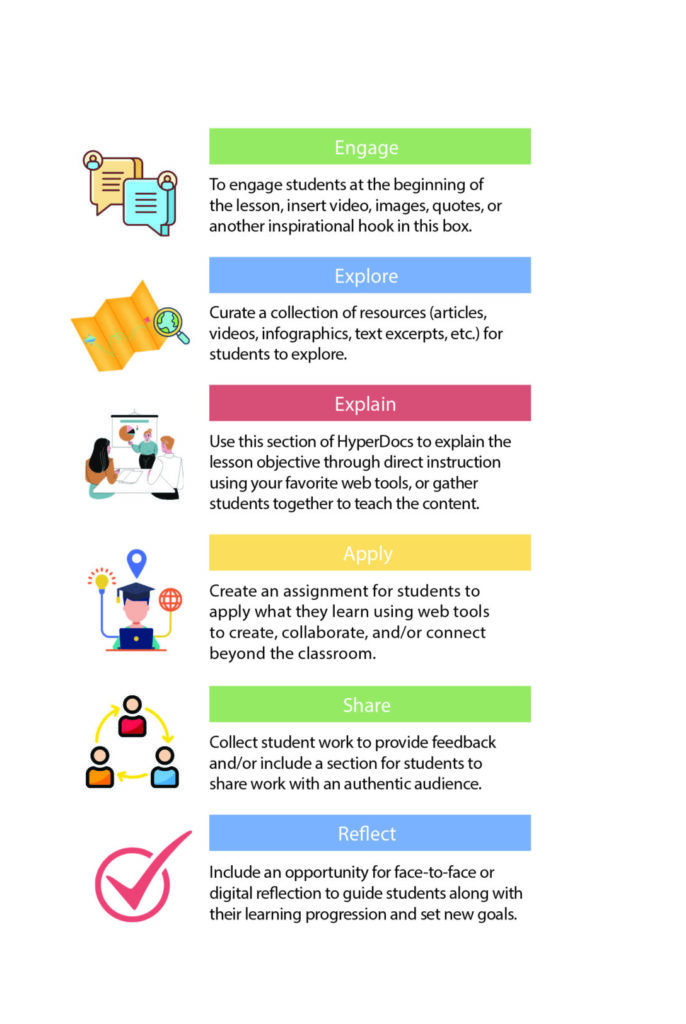Reimagine Education

The COVID-19 pandemic caused global disruption. This unique period has unveiled the inequities of an educational system ill prepared for rapid change, ubiquitous technology, the current workforce, and the demands of distance learning. Although this has been a traumatic and devastating experience for many people, it also provides a once-in-a-lifetime opportunity to reimagine and transform our outdated public education system.
What Is the Current Reality?
In the early 1900s, we saw the Second Industrial Revolution, and students were sitting in rows taking in content and information from their teachers. Today, we are living in the Fourth Industrial Revolution, and students are basically doing the same, this time through online environments provided through platforms such as Zoom, electronic whiteboards, and Google docs using devices such as iPads and laptops. We have gone 100 years and three industrial revolutions only to implement technology at the substitution level or the lower end of the Substitution, Augmentation, Modification, and Redefinition (SAMR) model. In the 2020–21 school year, with no other option, technology replaced the existing in-person communication process and the delivery of instruction. However, the opportunity to utilize it to design new learning experiences and expand opportunities is, thus far, abysmal.
The Organisation for Economic Co-operation and Development’s (OECD) The Future of Education and Skills 2030 Project, published in 2018, predicted the changes ahead of us, purporting, “We are facing unprecedented challenges—social, economic, and environmental—driven by accelerating globalization and a faster rate of technological developments. At the same time, those forces are providing us with myriad new opportunities for human advancement.”
This potential for human advancement includes improving education. The 2020–21 school year was challenging, yet the experiences gained from the pandemic have provided a learning opportunity like no other—and a chance to redesign school systems. States and the federal government have provided an unparalleled opportunity with state relief bills like Assembly Bill 86 in California; the Coronavirus Aid, Relief, and Economic Security Act; and the Coronavirus Response and Relief Supplemental Appropriations Act for local education agencies to mitigate learning losses while redesigning and transforming education. We must ensure that students are future-ready and able to meet the expectations of a Fourth Industrial Revolution and global workforce needs.
The current reality of the U.S. educational system is limping along with the following:
- Little appetite to define and design a quality education to meet future demands of 2030 and deliver effective Tier 1, Tier 2, and Tier 3 instruction
- A lack of necessary understanding and/or technological skills in many educators to maneuver and design blended learning environments
- An explosion in the digital divide between socioeconomic groups
- Lack of proper technology infrastructure and back-end support
- Instructional practices that do not match the social-emotional, academic, and, in many cases, cultural needs of digital natives, their communities, or the workforce
These deficiencies are glaring and have further highlighted the need to understand the sense of urgency and necessity for rapid change. Student behaviors during the pandemic have also provided educators with important data and insight. Students simply going missing or turning off their cameras while on Zoom has led to immense frustration for administrators, teachers, students, and parents, with each group sometimes looking to blame the other. The question is, what should this tell us? Is it insubordination, or is it an indication that a massive overhaul of the educational system is needed? There could be no better time to recognize and address outdated school practices and mitigate learning loss by designing accelerated learning opportunities and reimagining education.
How Can the Transformation Be Done?
With state bills such as California Assembly Bill 86 and the American Relief educational funds, money is no longer the excuse. The funding is being provided, but the will to direct the funds to the reimagining of education continues to be the crux of transformation. Navigating and leading systemic change will require school leaders and educators to stave off the myriad special interests and political powers that threaten real change and divert resources and focus. It will require educators to increase their knowledge and understanding of the world and the workforce, accept that the design and delivery of instruction must change, and then take action.

Where Do We Start?
With funding sources focused on supporting schools to develop expanded educational opportunities that address learning loss and overhaul an archaic school system, here are eight instructional steps that can be taken today to mitigate learning loss, accelerate and reimagine education, and further support teachers in designing relevant and engaging instruction:
- Provide all teachers with an understanding of the global megatrends, current workforce needs, and the impact caused by innovation game-changers such as technology—including data science, artificial intelligence, virtual reality, genome therapy, e-commerce, and video gaming—through professional development.
- Provide all teachers with training on workforce sectors and the OECD Global Competencies/Skills.
- Connect state content and grade-level standards to the OECD 2030 skills.
- Expand and further integrate technology, platforms, and digital tools, taking into consideration the various levels of integration (classroom, school, district).
- Retrain teachers to be facilitators of learning and educational coaches.
- Implement engaging and relevant instructional practices and strategies aligned to the social and emotional needs of students, including the contributions of the tapestry of cultures we serve and the global workforce.
- Use data to provide feedback and design new learning opportunities to enrich and accelerate learning (in Tier 1, Tier 2, and Tier 3 settings).
- Hire data coaches to help teachers use data effectively.
Teachers are no longer expected to simply plan lessons. They are expected to design, which is much more complex. Design requires teachers to understand how standards, global competencies, and digital tools intertwine to create relevant and engaging instruction. Lesson designing—not lesson planning—should be the focus. The two are very distinct. Lesson planning in traditional practice often is about simple preparation of materials and content to keep learners busy (e.g., books, materials, and copies). Lesson designing, in contrast, requires greater communication, collaboration, critical thinking, and creativity focused on learner competencies, skills, and outcomes.
With this said, lesson templates should be and need to be revisited often. Although many templates exist, one set that can be very useful and simple to integrate is from HyperDocs. These interactive lesson templates are designed to incorporate 21st-century skills and technology tools simultaneously. The company’s website provides various grade-level and content-area samples (see figure 1).
This leads to the last two components: using data assessment to provide feedback and hiring data coaches. Although assessment data is an important element, analyzing and interpreting data can be overwhelming and time-consuming for teachers. With the time limitations and instructional demands, teachers often struggle with analysis and interpretation and never arrive at the implementation stage, which is the most important piece of using data. This is where data coaches can be useful, saving time and assisting teachers in using the data to drive and support instruction. This, in turn, should help teachers to be more efficient in professional learning communities and more effectively assist with the design of new and innovative instruction.
What Now?
Now that districts and schools have the funds to make bold changes and transform education, the critical question is this: Who will have the courage to take the necessary actions to make this a reality? Let’s make this a grand opportunity to transform our educational system, catch up to the Fourth Industrial Revolution, and properly prepare our children for the current and future workforce, which is, by the way, the original intention of schools.
Cheryl James-Ward, EdD, is the CEO and chief engagement and innovation officer at e3 Civic High and a professor at San Diego State University in San Diego, CA. Christina Pierce, EdD, is the director of curriculum, instruction, and academic enrichment-education support services for the San Bernardino County Superintendent of Schools in San Bernardino, CA. Joel Tapia, EdD, is the director of human resources and data metrics for e3 Civic High in San Diego.
Sidebar: Building RanksTM Connections
Dimension: Innovation
Strategy 2: Managing change and uncertainty. To build an innovative learning environment, you should recognize that individuals react to change in various ways. You can help staff members, students, and parents embrace innovative ideas by being strategic about when and how you share new ideas, cultivating buy-in, leveraging stewards and coalitions, and addressing discord. Building a culture that accepts and initiates innovation requires transparency and attention to the change management needs of staff members, students, parents, and district office partners.
Innovation is part of the Leading Learning domain of Building Ranks.
